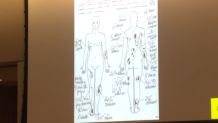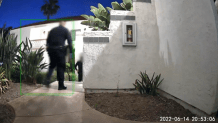A key argument between the defense and the prosecution about the death of Connie Dadkhah is over what killed her. The prosecution presented evidence from the medical examiner, stating Dadkhah was beaten to death and died from a brain bleed. The man accused of murdering her, Parrish Chambers Jr., has pleaded not guilty.
The defense has a different story. Public defender Abe Genser acknowledged that Chambers smashed his way into her condo through a second-story balcony sliding glass door and assaulted Dadkhah. But he says she survived the attack, reconciled with Chambers, had sex and then used methamphetamine. Genser says her death was due to an overdose.
Crime scene photos shown during testimony revealed a significant amount of blood throughout the condo: on the couch where Dadkhah's body was discovered, on the walls nearby, in the kitchen, in the bathroom and on the carpet.

But DNA testing of every blood sample didn't confirm any of it belonged specifically to Dadkhah, with the vast majority of it linked to Chambers. Instead, samples were tagged as uninformative in reference to Dadkhah. That doesn’t mean it wasn’t her blood, only that testing couldn’t verify that to a certain degree.
The defense called forensic scientist Chris Coleman, who agreed with Genser’s assertion that all the blood belonged to Chambers and was the result of broken glass injuries during the break-in.
“Are these blood spatters indicative of Mr. Chambers waving his arms around,” Genser asked.
“Yes it is,” Coleman replied.
Coleman testified that he would have expected to have more evidence if the prosecution’s story was accurate.

“You’d expect to find some blood evidence," Coleman testified. “Now I’ve looked at the injuries, and some of those injuries appear to be healing, so they’re older injuries. But any fresh injuries, you would expect there to be some drops of blood, some spatter, something, somewhere, that would come back to you.”
Autopsy photos showed that Dadkhah had a laceration to the back of her head and a bloody nose, but there was no pooling of blood where her body was found. Deputy district attorney Trisha Amador provided an explanation for that during cross-examination: her heart was no longer beating.

“It is also reasonable to conclude that she expired very quickly and that she didn’t have an opportunity to leave blood throughout the entire house,” Amador asked.
“Based on what I read on the autopsy report, it doesn’t look like it was that type of injury that would have been an immediate incapacitation,” Coleman answered.
"Did you see and review the multiple skull fractures that she received on various areas of her head and brain bleeds?” Amador asked.
“Yes I did," Coleman said.
Trial wrapping up next week

Witness testimony is expected to wrap up on Monday, followed by closing statements and jury instructions. Deliberations would then begin.
On the murder charge that Chambers faces, Judge Peter Deddeh ruled that the jury could find him guilty of 1st-degree murder, 2nd-degree murder or involuntary manslaughter. That’s based on the argument the defense has made that Chambers was voluntarily intoxicated and wasn’t consciously aware of what he was doing, and therefore didn’t have malice during the killing.
In addition to the murder charge, prosecutors also charged Chambers with three other crimes where they say Dadkhah was his victim. That includes two counts of battery and one count of false imprisonment. He’s pleaded not guilty to those counts as well.
The jury will also either find him guilty on both simple battery charges or acquit him on both charges. It’s because there aren’t exact dates the prosecution said the batteries happened, and only a range of dates.
Click here to read up on what happened during the other days of the murder trial. You can also watch replays of each day's proceedings the weekday after they happen, starting at 11:30 a.m.
Background on the murder case

On the morning of June 15, 2022, prosecutors say Chambers emerged from Dadkhah's condo, spattered with her blood. They say he flagged down a neighbor to call 911 to report that she was dead inside. He was taken into custody soon after and charged with her murder. He’s pleaded not guilty.
Police dispatch records show around 7 p.m. the night before, Dadkhah's neighbors began calling 911. They begged police to get there quickly, reporting that a belligerent man was trying to break into a woman’s condo. Initially, the call wasn’t prioritized. About an hour later, callers had new information to tell dispatchers: the man had scaled a wall to her second-floor balcony and smashed his way inside through a sliding glass door. While police upgraded the call to a higher priority, it took another 45 minutes for officers to arrive at the complex.

Those same dispatch records, along with court filings from prosecutors, reveal officers tried to make contact with Dadkhah by calling her phone, knocking on her door and using a loudspeaker. But officers left the scene 15 minutes later after failing to make contact with anyone inside. There’s no record of Dadkhah calling the police that night.
In defending their decision not to force entry the night before, police told NBC 7 Investigates they had reason to believe that Chambers lived there. That was based on a dispatch record accessed by responding officers. Police also told NBC 7 the decision to force entry into anyone’s home shouldn’t be taken lightly and is among the highest level of legal standards they operate under.
But Chambers didn’t live there, though NBC 7's investigation revealed a history between the two. Court filings show that included an incident in 2020 where Chambers was convicted of vandalism. The judge ordered Chambers to stay away from Dadkhah. That order was still in effect when Dadkhah died.
Previous coverage:
The exact nature of their relationship isn’t clear, but Dadkhah's friends say she met Chambers through her volunteer work with mental health outreach. They say he became smitten with her, tracked down her address and constantly visited despite repeated requests that Chambers leave her alone. The defense says the pair had a long abusive relationship centered on drugs.



